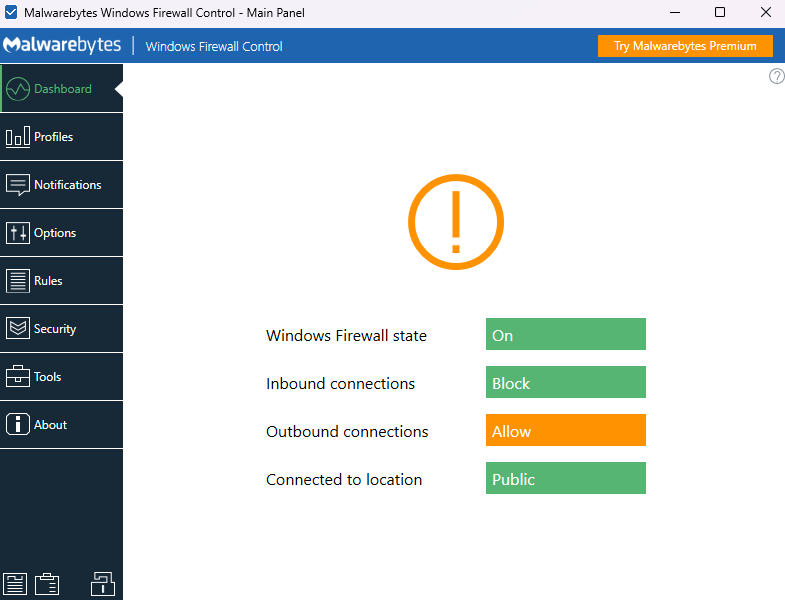Supercharging your Windows Firewall with Windows Firewall Control

Windows Firewall is a built-in security feature within Windows that helps protect your computer by filtering network traffic and blocking harmful or unauthorized connections. However, many users find it somewhat lacking in terms of advanced features and user-friendly management. This is where Windows Firewall Control (WFC) comes into play. WFC is a powerful tool that enhances the functionality of the Windows Firewall, providing a more comprehensive and accessible interface for managing your network security. In this blog post, we’ll explore how to supercharge your Windows Firewall using Malwarebytes Windows Firewall Control, highlighting its features, installation process, and tips for optimal use.
What is Windows Firewall Control?
Windows Firewall Control is a third-party software that works in conjunction with the built-in Windows Firewall, providing an intuitive interface and additional features that make managing your firewall easier and more effective. It does not replace the Windows Firewall but enhances its functionality, offering greater control and visibility over your network activity. With WFC, you can create and manage firewall rules, monitor network connections, and receive notifications about blocked connections, all from a user-friendly interface.
Installing Windows Firewall Control
- Intuitive User Interface: WFC provides a much more accessible and user-friendly interface compared to the default Windows Firewall settings. This makes it easier for both novice and advanced users to manage firewall rules and monitor network activity.
- Profile Management: WFC allows you to create different firewall profiles, which can be easily switched depending on your current network environment (e.g., home, work, public).
- Notifications and Alerts: Receive real-time notifications when a program attempts to connect to the internet. This helps in identifying and blocking unwanted connections.
- Rule Management: Easily create, modify, and delete firewall rules. You can also import and export rules for backup or transfer purposes.
- Connection Log: Monitor all active and recent network connections, providing detailed information about each connection and the associated application.
- Security Enhancements: WFC includes additional security features such as lockdown mode, which blocks all incoming and outgoing connections except those that are explicitly allowed.
- Integration with Malwarebytes: For users of Malwarebytes, WFC integrates seamlessly, providing an extra layer of security by automatically managing firewall rules for detected threats.
Step-by-Step Installation Guide
- Download the Installer: Visit the official Malwarebytes website and download the latest version of Windows Firewall Control.
- Run the Installer: Once the download is complete, run the installer. You may need administrative privileges to proceed with the installation.
- Follow the Setup Wizard: The setup wizard will guide you through the installation process. Accept the license agreement and choose your installation preferences.
- Launch WFC: After the installation is complete, launch Windows Firewall Control. You should see the WFC icon in your system tray.
- Initial Configuration: Upon first launch, WFC may prompt you to configure some basic settings, such as enabling notifications and setting a default profile. Follow the prompts to complete the initial setup.
Configuring Windows Firewall Control
Understanding the Interface
The main interface of WFC is divided into several sections:
- Dashboard: Provides an overview of your current firewall status, active connections, and recent notifications.
- Rules Panel: Allows you to view and manage your firewall rules. You can filter rules by profile, status, and direction (inbound/outbound).
- Connections Log: Displays detailed information about recent and active network connections, including the application name, IP address, and connection status.
- Profiles: Manage different firewall profiles for various network environments. You can create, modify, and switch between profiles with ease.
- Notifications: Configure how and when you receive notifications about network activity and blocked connections.
Creating and Managing Firewall Rules
Creating and managing firewall rules is one of the core functionalities of WFC. Here’s how to do it:
- Creating a Rule:
- Open the Rules Panel.
- Click on “New Rule” to start the rule creation wizard.
- Specify the program or service for which you want to create the rule.
- Choose the type of rule (allow or block) and configure the direction (inbound or outbound).
- Set additional parameters such as remote IP addresses, ports, and protocols.
- Save the rule.
- Modifying a Rule:
- In the Rules Panel, find the rule you want to modify.
- Right-click on the rule and select “Edit”.
- Make the necessary changes and save the rule.
- Deleting a Rule:
- In the Rules Panel, find the rule you want to delete.
- Right-click on the rule and select “Delete”.
- Importing/Exporting Rules:
- To export rules, click on “File” and select “Export Rules”. Choose a location to save the rules file.
- To import rules, click on “File” and select “Import Rules”. Locate the rules file and import it.
Monitoring Network Connections
The Connections Log provides detailed information about network activity:
- Viewing Active Connections:
- Open the Connections Log.
- View the list of active connections, which includes the application name, IP address, remote address, and connection status.
- Filtering Connections:
- Use the filters to narrow down the list of connections based on criteria such as direction (inbound/outbound), status (allowed/blocked), and time frame.
- Taking Action:
- Right-click on a connection to create a new rule based on its parameters or to terminate it.
- Right-click on a connection to create a new rule based on its parameters or to terminate it.
Advanced Features and Tips
Profile Management
Creating and using profiles allows you to tailor firewall settings to different environments:
- Creating a Profile:
- Open the Profiles section.
- Click on “New Profile” and name your profile.
- Configure the profile settings, including allowed and blocked rules.
- Switching Profiles:
- In the Profiles section, select the profile you want to activate.
- Editing Profiles:
- Select a profile and click “Edit” to modify its settings.
- Select a profile and click “Edit” to modify its settings.
Security Enhancements
WFC offers several advanced security features:
- Lockdown Mode:
- Activate lockdown mode to block all network traffic except explicitly allowed connections. This is useful in situations where maximum security is required.
- Secure Rules:
- Enable secure rules to prevent unauthorized changes to your firewall rules. This adds an extra layer of protection against malware and other threats.
- Notifications and Alerts:
- Customize notification settings to receive alerts for specific types of network activity. This helps quickly identify and respond to potential threats.
- Customize notification settings to receive alerts for specific types of network activity. This helps quickly identify and respond to potential threats.
Best Practices for Using Windows Firewall Control
- Regularly Review and Update Rules:
- Periodically review your firewall rules to ensure they are up-to-date and relevant. Remove any outdated or unnecessary rules to keep your firewall configuration clean and effective.
- Use Profiles for Different Environments:
- Create and use different profiles for network environments such as home, work, and public. This allows you to switch between settings optimized for security and functionality quickly.
- Enable Notifications:
- Enable notifications for blocked connections and other network activity to stay informed about potential threats and unauthorized access attempts.
- Backup Your Configuration:
- Export your firewall rules and configuration settings regularly as a backup. This ensures you can quickly restore your settings in case of a system crash or other issues.
- Export your firewall rules and configuration settings regularly as a backup. This ensures you can quickly restore your settings in case of a system crash or other issues.
Conclusion
Malwarebytes Windows Firewall Control is a powerful tool that significantly enhances the functionality and usability of the built-in Windows Firewall. By providing an intuitive interface, advanced rule management, real-time notifications, and additional security features, WFC allows users to take full control of their network security. Whether you’re a novice user looking for an easier way to manage your firewall or an advanced user seeking more granular control over your network activity, Malwarebytes Windows Firewall Control is an excellent addition to your security toolkit. By following the steps and best practices outlined in this guide, you can supercharge your Windows Firewall and ensure your computer remains protected against threats.
Did you enjoy this article? You can always find more of the latest news in CyberSecurity on our Home Page
